NDVI stands for "Normalized Difference Vegetation Index". NRG stands for "Near-infrared / Red / Green". NDVI and NRG are both ways to visualize the amounts of infrared and other wavelengths of light reflected from vegetation. Because both these methods compare ratios of blue and red light absorbed versus green and IR light reflected, they can be used to evaluate the health of vegetation. It's a snapshot of how much photosynthesis is happening. This is helpful in assessing vegetative health or stress. (Read more here: https://www.agronomy.org/publications/jeq/articles/36/3/832) ## Do-It-Yourself These techniques for vegetation analysis were developed for satellite imagery, but at Public Lab, we've been working a lot on capturing infrared imagery using our DIY [near-infrared camera](/wiki/near-infrared-camera) setup, and combining it with visible bands to produce NDVI images such as the one above. ## What these images mean What exactly are these images we're trying to make? What do they tell us about vegetation, and why? These diagrams should help to understand what it is we're doing and why these are good ways to analyze plant life. ## The NDVI equation [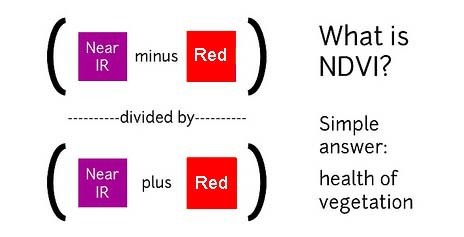](/i/44723) **NDVI = (Near Infrared - Red)/(Near Infrared + Red)** NDVI is a ratio which tries to emphasize photosynthesis while filtering out sun glare. The above equation is run for every pixel, using source data from an infrared photo and a visible light photo, like this pair: [](https://publiclab.org/system/images/photos/000/021/771/original/5390895115_c9d4d38fec_o.jpg) The result can be false-colored to make the high-photosynthesis areas more clear, and used to examine where plants are and how healthy they are. [](https://publiclab.org/system/images/photos/000/021/770/original/PetVISNDVIcomp.png) _Figure above: Normal color photo (right) and normalized difference vegetation index (NDVI) image (left). NDVI image was derived from two color channels in a single photo taken with a camera modified with a special infrared filter. Note that tree trunks, brown grass, and rocks have very low NDVI values because they are not photosynthetic. Healthy plants typically have NDVI values between 0.1 and 0.9. -- @cfastie_ ### Activities Here are a range of activities you can do to produce and interpret your own NDVI imagery, whether downloaded from a satellite imagery provider or [collected yourself using a DIY technique](/wiki/multispectral-imaging) [activities:ndvi] ****   Most DIY converted cameras today (those from Public Lab) use RGN instead of NRG, so the blue channel represents infrared instead of the red channel. That looks like this: [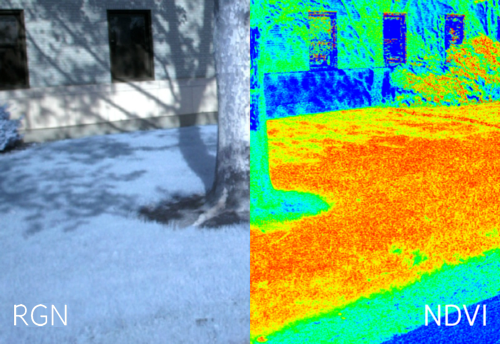](/i/45468?s=o) **** ## NRG imagery Some people are also interested in producing NRG imagery (like the below image), where `Near-Infrared, Red, and Green` are used to compose a picture instead of the usual `Red, Green, and Blue`. [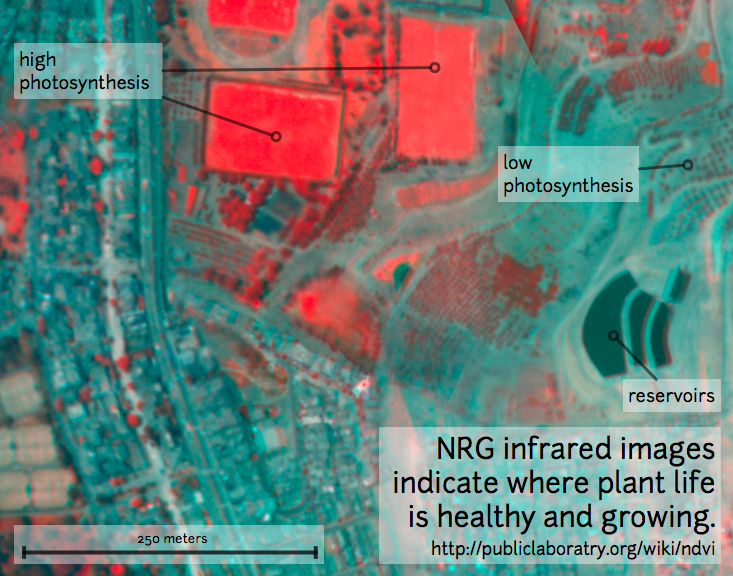](/i/25064) This diagram explains the swapping, which allows us to 'see' infrared as if it were a normal color: [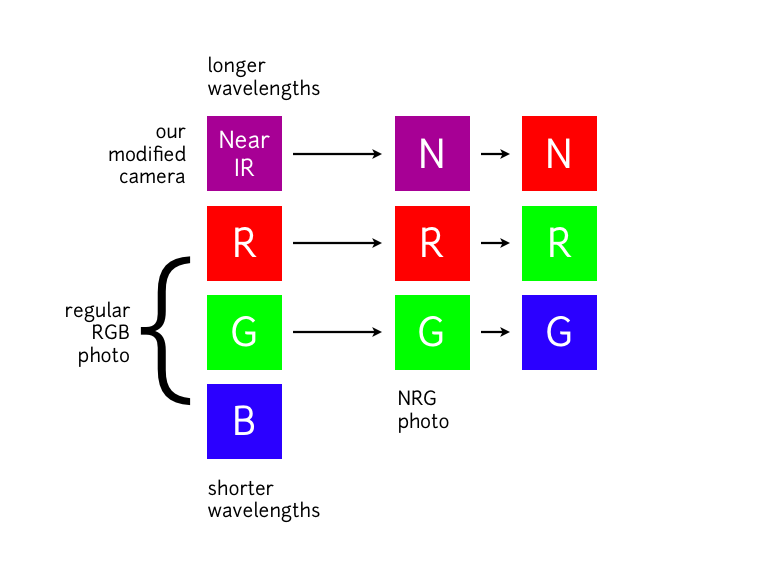](/i/25063) **In NRG images, the deeper and clearer the red color, the denser and healthier the vegetation (more or less).** ### Questions [questions:ndvi] ### Other examples of DIY NDVI imaging From around the internet: Begin watching at 2 minutes to see the resulting imagery: *This topic is part of the [Grassroots Mapping Curriculum](/wiki/mapping-curriculum) series.* **** [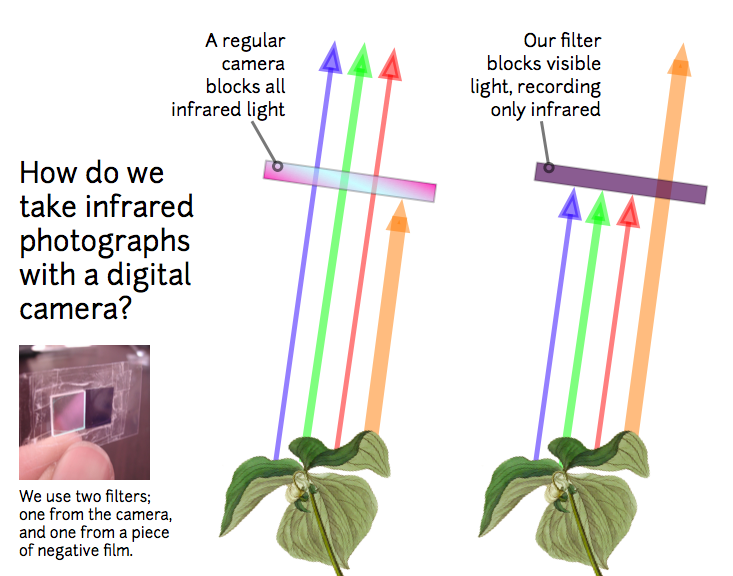](/i/25066) [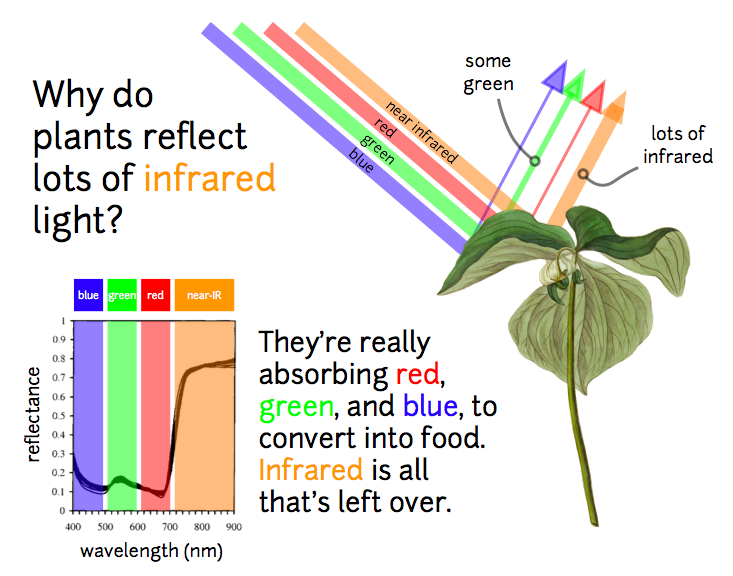](/i/25065) ...
| Author | Comment | Last activity | Moderation | ||
|---|---|---|---|---|---|
| eustatic | "thanks Chris! " | Read more » | about 11 years ago | |||
| John_Wells | "Hi Could you send me a full image file of your picture at the top of the page please....It looks very good. I would like to compare it with a conve..." | Read more » | about 11 years ago | |||
| cfastie | "Andy, That's a really good suggestion. You can see what this research note might look like to those who are red-green colorblind here (the gigapan ..." | Read more » | over 11 years ago | |||
| warren | "Thanks, loan!!! Very cool. I will def. use this as I develop this device. " | Read more » | over 11 years ago | |||
| ioan | "Hi Jeff Check this link: Raspi IP webcam It is in Romanian but you can use Google translate. You can add as many web cameras to Raspi as you whis..." | Read more » | over 11 years ago | |||
| pahenry | "Nice work! Thanks for sharing this. The color tables you generated produce very clear distinctions in the images. I would suggest one caution: The ..." | Read more » | over 11 years ago | |||
| warren | "I'm on the prowl for very small, short, mini USB cables now. I really want to find some with right-angle heads, since the connectors account for mu..." | Read more » | over 11 years ago | |||
| Bob | "Nice work. If you'd like to avoid the protruding SDHC card, adafruit has a microSD adapter: "Low-profile microSD card adapter for Raspberry Pi" " | Read more » | over 11 years ago | |||
| cfastie | "Hi Sara, The NDVI analysis did not get very far because these images did not register very well. Without good alignment of the NIR and visible imag..." | Read more » | over 11 years ago | |||
| sara | "Hi Chris, These photos are fantastic. Did the NDVI reveal anything the visible light photo didn't? It would be great to hear your analysis of the ..." | Read more » | over 11 years ago | |||
| donblair | "This is incredible. Quick thoughts: -- Can't get more "open hardware" than a cardboard box. Truly awesome. -- This suggests to me using an R-Pi ..." | Read more » | over 11 years ago | |||
| warren | "Luckily film strips are easy to mail around :-) Just a couple thoughts: I would expect a black and white type of image with all color channels ap..." | Read more » | over 11 years ago | |||
| JoshMc | "We'd also need to post pictures of the filters used on a camera, to check for clarity, etc. This would be nearly impossibly to standardize without..." | Read more » | over 11 years ago | |||
| JoshMc | "The simplest way to coordinate the testing would be to use the spectral workbench already in place on PLOTS. When you create a filter, run it thro..." | Read more » | over 11 years ago | |||
| nedhorning | "For me the end piece of developed film is far superior. It's sharp and the coloring is consistent across the image whereas the other is blurry a bi..." | Read more » | over 11 years ago | |||
| JoshMc | "This is very interesting! I was doing some research on adapting my own IR camera a few months ago, and came across a few sites that prescribed usi..." | Read more » | over 11 years ago | |||
| warren | "Kind of neat - i isolated each color channel to see how big the difference is. But it's not too informative: " | Read more » | over 11 years ago | |||
| cindy_excites | "Hi Warren, I will send you the two samples asap. The blurry picture is taken using a filter made from a piece of film that I pulled out fresh direc..." | Read more » | over 11 years ago | |||
| warren | "Wow, that is really remarkable. So the 1st one, pulled out and exposed, was it developed into negatives, or did you just use it directly after expo..." | Read more » | over 11 years ago | |||
| cfastie | "Except for the fact that their web site is more confusing than the plot of Lost, MaxMax is a really interesting company. The trick to the one cam..." | Read more » | over 11 years ago | |||
| gonzoearth | "The maps are online now here: http://publiclaboratory.org/map/salisbury-swamp-salisbury-vermont/2012-05-05 and here: http://publiclaboratory.org/ma..." | Read more » | over 11 years ago | |||
| Juan | "Excellent work. Congratulations! " | Read more » | almost 12 years ago | |||
| warren | "Just starting to put a few images in MapKnitter: https://mapknitter.org/map/view/cropcover-lee But the lack of references makes this pretty tough..." | Read more » | almost 12 years ago | |||
| cfastie | "Thanks, Mathew. Yes, 3D is very awesome. This was Jeff's idea to try this, and the images he captured flying high over the field made it possible..." | Read more » | almost 12 years ago |